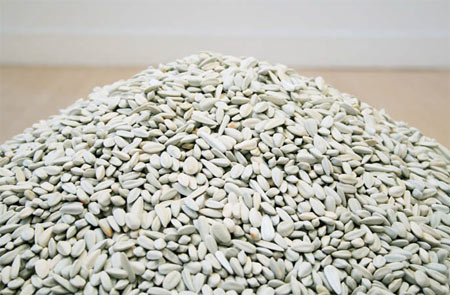
This Ai Weiwei show is important for many reasons, not all of which have to do with the specific work on view. Hailing from Beijing, Weiwei is at the forefront of the increasingly vibrant conversation the international art world is having about contemporary Asian art, especially that coming out of China. An activist and forceful critic of the Chinese government (he was beaten by the Chinese police last year and suffered life-threatening head injuries because of it), Weiwei’s art gives outsiders intimate insight into Chinese culture and current issues through the universal language of objects and concepts. His work also resonates within Western art history. Obvious influences and references can be made to Marcel Duchamp, Félix González-Torres, Andy Warhol, as well as contemporaries such as Jeff Koons. Similarly to other mega-artists, Weiwei employs loads of assistants to transform his vision into form.
Weiwei is a conceptualist; the greater message of his pieces is not immediately evident. Where his work succeeds is that it engages us to the point of curiosity. The pieces included here — all recent sculpture (2006–2010) in various mediums, including porcelain, marble, and canvas packs — are pretty, sometimes luscious, and simple. They are easy points of entry to sometimes difficult subjects.
Perhaps most powerful — at almost sixty feet long, it has quite a presence — is “Snake Bag,” a series of 360 backpacks zippered together in the form of a serpent. The work is a memorial to the thousands of children who perished in the 2008 Sichuan Province earthquake; Weiwei holds the government responsible for the excessiveness of the death toll (it was this criticism that led to the police beatings). “Kui Hua Zi” (sunflower seeds) is another strong work. Comprised of 550 pounds of porcelain seeds piled in a conical shape (it took twenty assistants more than a year to hand-make all the “seeds”), it’s a nod to the famine diet of peasants during Mao’s Great Leap Forward, which spanned the years 1959 to 1961. The work readily quotes Gonzalez-Torres’s candy piles, albeit appropriately relaying a slightly less generous twist.
Of particular interest to the Bay Area is “Owl Houses,” a collection of ten hand-painted porcelain structures meant to be owl habitats. These will soon be installed in the San Francisco Presidio to serve their sheltering purpose as part of “Presidio Habitats,” an on-site group exhibition that launches May 15th and runs for a year. This is the first major gallery exhibition of Weiwei’s work on the West Coast. Go to see some lovely work, stay for the conversation.
